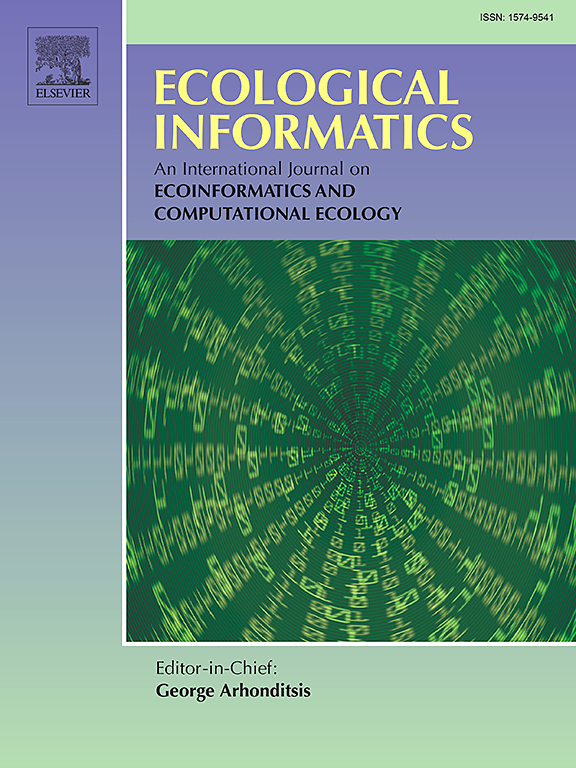Analysing vocal complexity in relation to sociality in orcas of British Columbia: An application of long-term computational passive acoustics
IF 5.8
2区 环境科学与生态学
Q1 ECOLOGY
引用次数: 0
Abstract
Orcas are both highly social and highly vocal animals. In coastal waters of the North-Eastern Pacific Ocean, the Northern Resident orca population is well monitored, providing a great opportunity to learn about their social and communicative behaviour. Here, we report a series of acoustic analyses that lead to the empirical assessment of factors that might impact vocal complexity.
Automatically processing long-term passive acoustic data, we detected and classified calls to transcribe vocal activity. Detailed post-hoc analyses show that the detection model is imperfect, especially in detecting calls of low energy. Also, diarisation is not possible with this data and transcriptions might gather a mixture of several emitters. Taking these limitations into account, we measured communicative complexity considering the groups’ vocal production as a whole. Acoustic and visual cues also enabled the identification of specific groups with estimated numbers of individuals.
Results highlight a positive correlation between vocal and social complexity, which could be due to the mere effect of having more potential emitters. Nonetheless, this brings a first demonstration of the non-trivial link between the number of emitters and complexity in the composition of sequences. We also demonstrate significant impacts of other proximate factors such as behaviour on vocal complexity measurements, and advocate for multi-factor considerations when evaluating communicative complexity.
This work demonstrates the pertinence of joint efforts between passive acoustics, visual observations and machine learning to enhance the scale of behavioural studies and assess the validity of evolutionary hypotheses of communication systems.
分析与不列颠哥伦比亚省虎鲸社会性有关的声音复杂性:长期计算被动声学的应用
逆戟鲸是高度群居和高度发声的动物。在东北太平洋的沿海水域,北方虎鲸的种群受到了很好的监测,这为了解它们的社会和交流行为提供了一个很好的机会。在这里,我们报告了一系列的声学分析,导致可能影响声乐复杂性的因素的经验评估。自动处理长期被动声学数据,我们检测和分类呼叫转录声乐活动。详细的事后分析表明,检测模型是不完善的,特别是在检测低能量呼叫时。此外,这些数据不可能进行日记化,转录可能会收集几个排放者的混合物。考虑到这些限制,我们衡量交流的复杂性考虑到群体的声乐生产作为一个整体。声音和视觉线索也使识别特定群体与估计的个体数量。结果强调了声音和社会复杂性之间的正相关关系,这可能是由于拥有更多潜在排放者的单纯影响。尽管如此,这首次证明了发射体的数量与序列组成的复杂性之间的重要联系。我们还证明了其他近似因素(如行为)对声音复杂性测量的显著影响,并主张在评估沟通复杂性时考虑多因素。这项工作证明了被动声学、视觉观察和机器学习之间共同努力的相关性,以增强行为研究的规模,并评估通信系统进化假设的有效性。
本文章由计算机程序翻译,如有差异,请以英文原文为准。
求助全文
约1分钟内获得全文
求助全文
来源期刊

Ecological Informatics
环境科学-生态学
CiteScore
8.30
自引率
11.80%
发文量
346
审稿时长
46 days
期刊介绍:
The journal Ecological Informatics is devoted to the publication of high quality, peer-reviewed articles on all aspects of computational ecology, data science and biogeography. The scope of the journal takes into account the data-intensive nature of ecology, the growing capacity of information technology to access, harness and leverage complex data as well as the critical need for informing sustainable management in view of global environmental and climate change.
The nature of the journal is interdisciplinary at the crossover between ecology and informatics. It focuses on novel concepts and techniques for image- and genome-based monitoring and interpretation, sensor- and multimedia-based data acquisition, internet-based data archiving and sharing, data assimilation, modelling and prediction of ecological data.
 求助内容:
求助内容: 应助结果提醒方式:
应助结果提醒方式:


